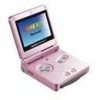Nintendo 1504166 Programming Manual - Page 13
AGB System, 1.1 System Overview, AGB CPU, Downward Compatibility with CGB, Memory, Display
 |
View all Nintendo 1504166 manuals
Add to My Manuals
Save this manual to your list of manuals |
Page 13 highlights
AGB Programming Manual AGB System 1 AGB System 1.1 System Overview AGB is a portable game device that maintains downward compatibility with Game Boy Color (CGB) and provides higher performance. AGB's 2.9-inch-wide reflective TFT color LCD and 32-bit RISC CPU enable production of games that match or surpass the Super Nintendo Entertainment System (Super NES) in performance. AGB CPU 32-bit RISC CPU (ARM7TDMI)/16.78 MHz Downward Compatibility with CGB Integral 8-bit CISC CPU for compatibility (However, it cannot operate at the same time as the AGB CPU.) Memory System ROM Working RAM VRAM OAM Palette RAM Game Pak memory 16 Kbytes (and 2 Kbytes for CGB System ROM) 32 Kbytes + CPU External 256 Kbytes (2 wait) 96 Kbytes 64 bits x 128 16 bits x 512 (256 colors for OBJ ; 256 colors for BG) Up to 32 MB: mask ROM or flash memory (&EEPROM) + Up to 512 Kbits: SRAM or flash memory Display 240 x 160 x RGB dots 32,768 colors simultaneously displayable Special effects features (rotation/scaling, α blending, fade-in/fade-out, and mosaic) 4 image system modes Operation Operating keys (A, B, L, R, START, SELECT, and Control Pad) Sound 4 sounds (corresponding to CGB sounds) + 2 CPU direct sounds (PCM format) Communication Serial communication (8 bit/32 bit, UART, Multi-player, General-purpose, JOY Bus) ©1999 - 2001 Nintendo of America Inc. 13 D.C.N. AGB-06-0001-002B4















